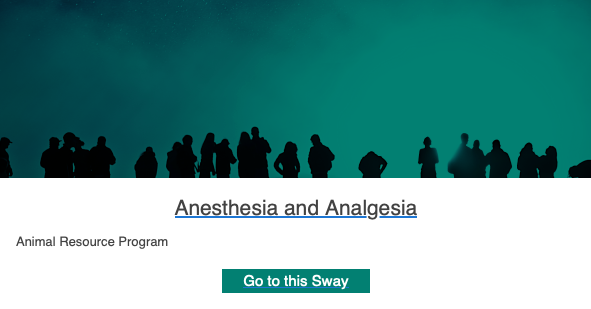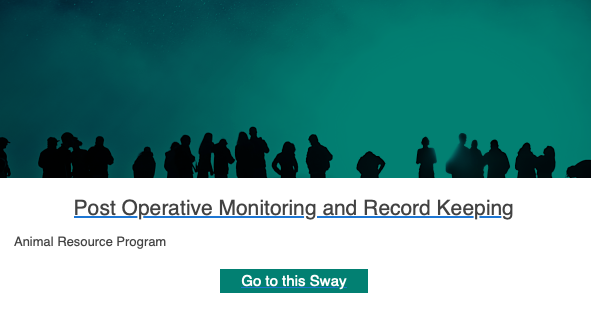Anesthesia, Analgesia and Surgery
ARP strongly recommends the use of a peri-operative checklist for all surgeries to minimize the potential for life threatening errors. A sample checklist is available that can be modified as needed.
Anesthesia
General anesthesia, a condition in which an animal is unconscious and completely insensible to pain, is necessary for surgery and other painful or distressful procedures. Please consult with an ARP veterinarian regarding anesthetic choice. General guidelines:
- Inhalation (gas) anesthesia using isoflurane is recommended for rodent surgeries. Survival rates are typically higher and recovery faster compared to injectable anesthesia.
- Injectable anesthetics administered to rodents may not reliably produce a surgical plane of anesthesia. The duration of anesthesia is variable and recovery is prolonged.
- Rodents breathing room air after administration of injectable anesthetic drugs become hypoxic (i.e., decreased oxygen levels in the blood) within a few minutes after losing consciousness. Hypoxia often leads to delayed anesthetic recovery and/or death. It is recommended that 100% oxygen be supplied via nosecone to all rodents anesthetized with injectable drugs.
- Drugs are available that can shorten (‘reverse’) anesthesia time for certain injectable anesthetics, but these should not be given until at least 30 minutes after anesthetic administration.
- Certain drugs used for anesthesia, analgesia, and euthanasia are regulated by the DEA (Drug Enforcement Administration) because of the potential for abuse. Investigators using these drugs are responsible for complying with applicable regulations.
Anesthetic Monitoring
Verify that the animal is not able to feel pain by firmly pinching the rear paw at least every 5 minutes. If the animal moves it is too lightly anesthetized for painful procedures. Consider using an alarm set to beep at 5-minute intervals to remind you to check the animal throughout the procedure.
Observe respiration and mucous membrane color. Changes (e.g., shallow, infrequent breathing; blue-tinged mucous membranes) are indicators that an animal is in trouble and intervention is required. Consider decreasing isoflurane flow rate and increasing oxygen flow if using gas anesthesia. If using injectable anesthesia, consider administering an appropriate reversal agent and/or increasing oxygen flow rate. Note: anesthetized animals that appear to be gasping with an open mouth are often near death. Immediate aministration of an appropriate reversal agent may give the animal a chance to recover.
A pulse oximeter can be used to monitor heart rate and blood oxygen levels. The SpO2 should be at least 95%. Values less than 95% indicate mild hypoxia. SpO2 values of 90% or less indicate significant hypoxia and require immediate O2 supplementation and reduction in isoflurane flow.
Body Temperature
Body temperature drops significantly within a few minutes after induction of anesthesia in small animals. Below normal body temperature (hypothermia) significantly affects physiological function, prolongs anesthetic recovery and can cause death in anesthetized rodents. Rodent rectal probes are available for monitoring body temperature in anesthetized animals.
Anesthetized animals must be provided with supplemental heat at least until they are recovered from anesthesia. In some cases, after prolonged or invasive surgical procedures, supplemental heat should be provided to the rodent cage for up to several days.
During surgery, circulating water blankets or far-infrared heating pads specifically made for rodents are commonly used. Post-operatively, recovery cages may be placed onto these or other devices that will provide gentle heat. With any device, care must be taken to prevent overheating. Electric heating pads and heat lamps are not acceptable as they can burn the skin and extremities.
Prevention of Fluid Loss
Rodents may experience fluid loss during and after surgery due to lack of fluid intake during anesthesia and recovery, evaporation from exposed body tissues and cavities, and bleeding. To reduce intra-operative fluid loss the surgeon should control blood loss by clamping and/or ligating bleeding vessels and gently irrigating exposed tissues with warmed sterile saline. The animal’s water and food intake and body weight should also be monitored as part of post-operative care. Warm (36-37°C; 96.8-98.6°F), sterile fluids (e.g., 0.9% NaCl) may be injected subcutaneously during surgery or prior to anesthetic recovery. Rodents undergoing frequent anesthetic procedures may also benefit from low doses of SC fluids.
Recommended subcutaneous injection volumes to prevent dehydration:
- Mouse: 5 ml/kg total
- Rat: 5 ml/kg total; not > 5.0 ml per site
Analgesia
Animals that are likely to experience post-procedural pain must receive analgesic medication. Analgesic protocols must take into account the severity and duration of pain expected for the procedure. The World Small Animal Veterinary Association has developed a guide to expected pain severity levels for a variety of conditions in dogs and cats. Although every species is different, this guide may provide a basis for predicting pain severity in rodents and other animal species. Examples of designated condtions and corresponding pain severity:
| Severe | ||
| Spinal surgery | Bone cancer | |
| Burn injury | Orthopedic surgery | |
| Meningitis | Limb amputation | |
| Necrotizing pancreatitis | Extensive inflammation (e.g., peritonitis, fascitis) | |
| Neuropathic pain (nerve entrapment/inflammation) | Thrombosis/ischaemia | |
| Moderate to severe (varies with degree of injury or illness) | ||
| Immune mediated arthritis | Major soft tissue surgery | |
| Glaucoma | Corneal abrasion/ulceration | |
| Extensive resection for mass removal and corrective orthopedic surgery | Oral cancer | |
| Moderate | ||
| Soft tissue injuries | Osteoarthritis | |
| Ovariohysterectomy | Diagnostic arthroscopy and laparoscopy | |
| Mild to moderate | ||
| Minor soft tissue surgery | Superficial lacerations | |
| Dental disease | Castration | |
Analgesics should be administered prior to anesthetic recovery (from painful procedures) to minimize the development of post-procedural pain. Animals must be evaluated regularly post-procedurally and additional doses of analgesic medication given based on a subjective assessment of the degree of pain experienced by each animal. In most cases analgesics should be administered by injection. Although analgesic drugs can sometimes be placed in drinking water or food for oral delivery this is not effective if the animal is not eating or drinking or if the medication makes the food or water taste bad.
Clinical signs associated with pain in rodents are variable between species and individuals. Rodents tend not to show obvious signs of pain until they are severely affected. Mild to moderate pain frequently leads to subtle behavioral changes that are hard to recognize without careful, experienced observation. Signs of pain are usually not specific. Prior knowledge of recent surgery or other painful procedures can help the observer differentiate between clinical signs caused by pain and those caused by illness or other distressful situations.
Examples of clinical signs that are associated with pain in rats and mice are listed below. These signs are not, by themselves, specific for pain. The presence of these signs indicates the animal is suffering and in discomfort. This may be the result of pain, especially if a painful procedure, such as surgery, was recently performed.
- Hunched posture and/or reluctance to move
- Isolation from cage mates and/or apathetic behavior (unaware or unconcerned about what is going on around it)
- Rough, greasy or ungroomed coat
- Facial grimacing
- Back arching or flank contractions (after abdominal surgery or procedures)
- Porphyrin staining around the eyes, nose or on the fur of rats
An ARP veterinarian must be consulted if a research animal shows clinical signs suggestive of pain or distress after surgery. A veterinarian may be reached 24 hours a day by calling the Animal Resource Program Office at 814-865-1495 (This phone number is posted in the animal facilities). If calling after hours, a recorded message will provide contact information.
Preparation For a Surgical Procedure
Instrument Preparation
Instruments, suture material and all other equipment and material that will enter the sterile field must be sterile prior to surgery. Instruments and other equipment that can withstand high heat and steam are typically autoclaved. Non-autoclavable material may be purchased presterilized or gas sterilized.
Location for Surgery
The surgical area should be uncluttered and easily disinfected. For rodents, the area should be dedicated to surgery during the procedure but may be used for other purposes when not being used for surgery. Patient preparation and recovery should take place in a location separated from the surgical area although it may be in the same room.
Surgical Attire
Rodent survival surgery must be performed using sterile gloves, a clean lab coat or gown and a facemask. A head covering is recommended to reduce the risk of stray hair falling into the operative field. Instrument tip surgery does not require sterile gloves although it is recommended. At the very least, clean exam gloves should be worn for these procedures.
Record Keeping
Investigators must keep accurate records of anesthesia, surgery and postoperative care (including analgesic administration). Information on groups of rodents treated similarly may be entered on a single medical record. Records must be kept in the animal room or an accessible area nearby for easy access by veterinary and IACUC personnel.
Information to Include on Surgical Records:
- Date of surgery
- Name of surgeon
- A description of the surgical procedure
- Animal identification i.e., number or group name
- Name(s), dosage(s) and route(s) of administration of anesthetic and analgesic drugs
- Name(s) and dosage(s) of experimental agents administered
- Post-operative monitoring that clearly documents daily observation and health status
- Medical treatments administered during or after surgery
Post-operative Complications
Unexpected complications occasionally occur in association with surgery or post-operative recovery. An ARP veterinarian must be consulted to ensure the welfare of the animal. A veterinarian can be reached 24 hours a day by calling the Animal Resource Program Office at 814-865-1495 (This phone number is posted in all animal facilities). If calling after hours, a recorded message will provide veterinary contact information.
Common Problems
Hypothermia – Animals that have become cold during the surgical procedure will recover very slowly and will often die. It is extremely important to keep animals warm during and after the procedure.
Prolonged recovery – Hypothermia, hypoglycemia, dehydration, and anesthetic overdose may all contribute to prolonged recovery.
Anesthetic overdose – Repeated injections of anesthetics during lengthy procedures may lead to prolonged recovery and occasionally death. Inhalation anesthesia is the preferred method of general anesthesia for rodents because anesthetic depth may be quickly and easily adjusted as needed during the procedure.
Respiratory failure and death - The carrier gas (oxygen or room air) for isoflurane anesthesia must be humidified if the animal will be anesthetized for a long time (e.g., > 1 hour). Nebulizers for rodent isoflurane vaporizers are available and easy to use.
Swollen inflamed surgical wound – may be caused by rough tissue handling, poorly placed sutures or infection. Refinement to your surgical technique or additional training should be considered. Missing wound clips or sutures: Contact an ARP veterinarian unless the wound appears to be fully healed
Abnormal Behavior – The animals may be in pain or distress. You should be familiar with the signs a rodent may display if it is in pain and know what pain relief will be provided to animals on your protocol. If animals show unexpected pain or distress, an ARP veterinarian must be consulted.
Investigators whose protocols include surgical procedures on research animals at Penn State must meet specific requirements for the preparation and conduct of those procedures. The PSU IACUC requires completion of the online training listed below. In addition, ARP offers online and in-person training in surgery for PSU faculty, staff and students. The ARP training is not mandatory but strongly recommended. The ARP Rodent Surgery Manual is also available online and provides comprehensive information about rodent surgery for PSU researchers. Animal Resource Program veterinarians have experience with rodent surgery and are available for consultation.
Information on anesthesia and analgesia in laboratory animals may be found by following the links at the top of this page or in the menu on the left.
IACUC Rodent Surgery Training Requirements
Personnel must complete the following training prior to performing rodent surgical procedures at Penn State:
- Read the IACUC Rodent Surgery Guidelines .
- Complete the Research Animal Training Aseptic Technique training videos available online. There are a total of eight short videos to watch. Please note that although PSU does not require rodent surgeons to wear sterile gowns or use sterile towels to dry their hands after washing in preparation for surgery, these materials should be clean and unused.
- Complete the IACUC Rodent Surgery Training online tutorial with associated quiz.
It is strongly recommended that personnel obtain additional training from ARP or other qualified and experienced personnel, including but not limited to the following:
- ARP Mouse or Rat biomethodology training
- Aseptic Technique and General Surgery training classes available on the ARP website
- Sharps Safety When Working with Research Animals
- Rodent Surgery Training manual
- Procedure specific training provided by ARP veterinarians
IACUC Oversight
A veterinarian representing the IACUC will review your surgical records every six months. The following points will be reviewed at the time of inspection:
- Are the records legible?
- Is the person listed as the surgeon authorized to conduct the procedure?
- Is there a record of analgesic administration?
- Is there a description of the procedure available?
- Is there a record of daily post operative evaluation?
Recommendations for Learning a New Surgical Procedure
- Familiarize yourself with the relevant anatomy of the species you will be using.
- Observe an experienced surgeon perform the procedure.
- Develop your technique first using cadaver animals.
- If available, practice the procedure on anesthetized animals that will be euthanized before recovery from anesthesia.
- It is not recommended that you try to obtain experimental data from practice or training animals.
ARP Aseptic Technique and General Surgery Training class
The Aseptic Technique and General Surgery Training class consists of online and in-person components. Completion of both online and in-person parts of the class are necessary for participation to be recorded. After viewing the four online presentations (found on this webpage) an online form must be completed to sign up for the in-person part of the training class. In-person sessions will last approximately 2 hours and include training in wound closure, aseptic technique and rodent pain/distress recognition. This training is intended for PSU faculty, staff and students listed on currently approved IACUC protocols using surgery.
Please note: The online surgery training class found here is not the same as the PSU IACUC-required online Rodent Surgery Training tutorial.
If you have little or no experience working with rodents, please complete the ARP Mouse or Rat biomethodology training, including the in-person class session, prior to completing this surgery training.
Read through all the online material. This class contains multiple sections (presentations) and includes hyperlinks to videos or documents that you are expected to view. After viewing the online presentations, complete the online form to sign-up to attend an in-person training session. If, after completing this class, you need additional training in a specific surgical procedure please contact the ARP or an ARP veterinary technician or veterinarian. We will schedule training sessions to meet your needs.
The information presented on this website is intended as a resource for Pennsylvania State University research investigators. No guarantee of efficacy or safety is made nor must information obtained from this site be substituted for professional veterinary advice. Please contact the ARP at arp-help@psu.edu for additional information or if you are experiencing technical difficulties with the online training.




